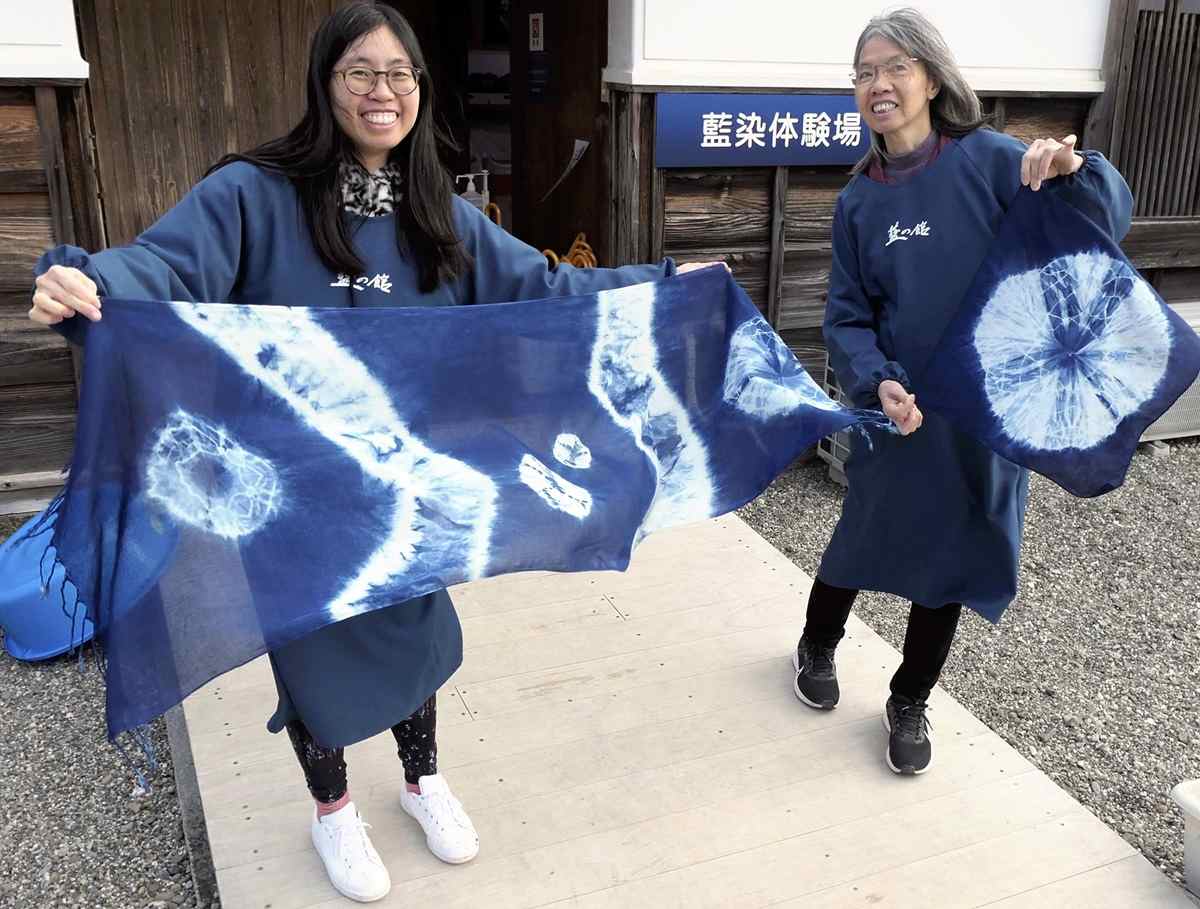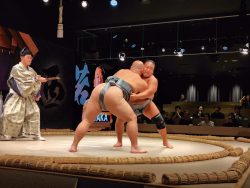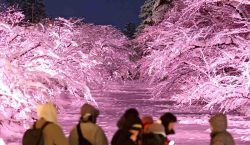
Chan Yuk Ping, right, and her daughter Joyce Wong show off their finished indigo-dyed fabric.
15:57 JST, January 27, 2024
AIZUMI, Tokushima — The chance to experience indigo tie-dyeing is attracting tourists to Tokushima Prefecture, Japan’s largest producer of natural indigo dye, with 30% of tour participants visiting from overseas.
In early December, Chan Yuk Ping, 61, and her daughter Joyce Wong, 38, tried their hand at indigo dyeing at the Historical Museum Ainoyakata in the town of Aizumi.
The pair, who are originally from Hong Kong and live in London, gently dipped a stick wrapped with a cloth tied with rubber bands into a vat of dye solution. It is made from fermented indigo leaves, called sukumo. The cloth is soaked in the solution for about a minute, taken out, then submerged again. The process is repeated five times.
When the cloth is spread out, the areas squeezed by the rubber bands form white patterns. After washing with water, a vivid indigo gradation emerges from the darker dyed areas.
“Wow, so beautiful,” the visitors exclaimed in surprise when they saw the emerging patterns.
Wong, who said that she was comforted by the colors, listened intently to 26-year-old curator Yuki Katsuno speaking about the production process and seemed to be impressed by how much time and effort it takes to dye fabrics.
Best indigo in Japan

Indigo dye from the prefecture is called Awa ai, or Awa indigo, named after the old province name of Tokushima Prefecture. Awa indigo was considered the best in the country during the Edo period (1603-1867). Indigo blue, also known as “Japan blue,” was adopted as the color of the official emblem for the Tokyo Olympics and Paralympics that were held in 2021.
The Aizumi town government opened the museum in 1989 after receiving a mansion and other gifts from the Okumura family, a wealthy merchant family that had been producing and selling Awa indigo dye since the Edo period. The museum has long been a symbol of Tokushima’s status as Japan’s largest producer of indigo plants and sukumo.
The coronavirus pandemic forced the museum to close for 1½ years from April 2021. During that time, anticipating a recovery in the number of foreign visitors, the museum installed a new monitor screen showing videos and cartoon panels explaining the cultivation and production processes. The museum reopened in November 2022 with improved explanations in English and Chinese.
About 11,000 people sign up for the tie-dye workshop each year, with 10% of the total made up of foreign tourists until around 2016. Boosted by coverage in overseas travel magazines and online, the share of foreign tourists has increased to about 30% today. Katsuno said she studied English to help provide explanations.
“I want foreign visitors to know that Tokushima is the home of Japanese indigo,” she said.
Revival of dye production
Aizumi Ai Kobo, a town-run indigo facility that opened in May 2021, supplies sukumo to the museum. Indigo seedlings are sown in spring, and the leaves are harvested during the summer and autumn seasons. Sukumo is produced using a traditional method of finely grinding the leaves before sprinkling with water and fermenting for about 100 days.

Staff members of the Historical Museum Ainoyakat
Indigo cultivation and sukumo production had come to an end in Aizumi, but since 2018, people who relocated to the town under the central government’s local vitalization project have been working to revive the traditional production.
Kosuke Asano, an inaugural member from Kyoto Prefecture, remained in the town as an employee after his term as a project member ended in 2021. He continues to produce indigo at the facility.
“Indigo dyeing begins with cultivation and even after that it takes a lot of time and effort to only produce a small amount of sukumo,” Asano, 33, said. “I would be happy if people knew that it’s not something anyone can do.”
From April, Ainoyakata will begin a more authentic tie-dyeing class in which participants will be able to sew patterns with threads.
“This is the only facility in Japan where you can fully experience Awa indigo through dyeing,” said Director Mitsuko Mori, who has been involved with the museum since its opening. “We would like to promote this both domestically and internationally.”
Year-round, stay-type tourism
In the eastern part of Tokushima Prefecture, efforts are being made to shift from events-based tourism, such as viewing the Awa Odori dance as well as the Naruto whirlpools, to so-called year-round, stay-type tourism whereby visitors enjoy nature and traditional industries.

The Awa Odori dance festival

Naruto whirlpools
The East Tokushima Tourism Authority, the organization that plans to promote tourism in the eastern part of Tokushima Prefecture, positions eastern Tokushima as the “gateway to the Shikoku region,” and through its website introduces hiking courses that take visitors through mountains and valleys in the region, such as Mt. Bizan and the town of Kamikatsu. Information is also provided on about 40 locations where visitors can experience traditional industries such as sake breweries, kilns and textile makers.
Related Tags
"Features" POPULAR ARTICLE
-

Students Recreate 19th-Century Bento Boxes Made for Ino Tadataka’s Survey Team in Hot Spring Town on Nakasendo Road
-

Santa Claus Delivers Christmas Presents to Penguins at Aquarium in Japan’s Nagasaki Prefecture
-

Sumo Restaurant in Tokyo Teaches Foreign Visitors About the Ancient Sport, with Bouts Between Retired Rikishi
-

Autonomous Passenger Ship Connects Mainland with Remote Island in Seto Inland Sea; World’s 1st Commercially Operated Autonomous Vessel
-

Osaka’s Sumiyoshi Taisha Shrine Bustles with New Year’s Visitors
JN ACCESS RANKING
-

As Chinese Tourists Shun Japan, Hotels and Stores Suffer
-

Osaka-Kansai Expo’s Economic Impact Estimated at ¥3.6 Trillion, Takes Actual Visitor Numbers into Account
-

Japan Govt Adopts Measures to Curb Mega Solar Power Plant Projects Amid Environmental Concerns
-

BOJ Gov. Ueda: Highly Likely Mechanism for Rising Wages, Prices Will Be Maintained
-

Economic Security Panels Debate Supply Chains, Rare Earths; Participants Emphasize Importance of Cooperation Among Allies




























